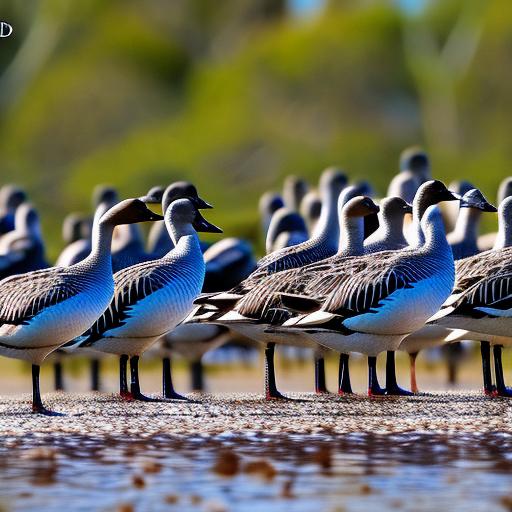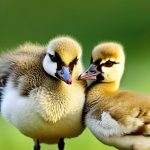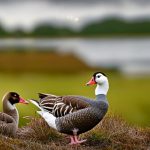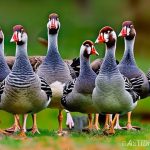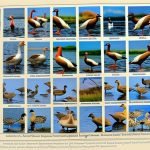Geese are a type of waterfowl that have been domesticated for centuries. They are known for their distinctive honking sound and their ability to adapt to various environments. In Australian agriculture, geese play a crucial role in pest control, weed management, and even as a source of meat and eggs. They are highly valued for their ability to graze on grass and weeds, making them an efficient and sustainable option for farmers.
Geese have been popular in Australia for many years, with their numbers steadily increasing. They are often seen on farms and rural properties, where they are used for various purposes. Their popularity can be attributed to their hardiness, adaptability, and the benefits they bring to agricultural practices.
Key Takeaways
- Geese play an important role in Australian agriculture as they are used for meat, eggs, and feathers.
- The top 5 most popular breeds of geese in Australia are Embden, Toulouse, Chinese, African, and Sebastopol.
- Geese were introduced to Australia in the 1800s and were primarily used for their feathers.
- Australian geese have unique characteristics such as their ability to adapt to different environments and their strong maternal instincts.
- Raising geese in Australia can be beneficial for their meat and egg production, but also comes with challenges such as disease management and finding the ideal habitat.
The Top 5 Most Popular Breeds of Geese in Australia
1. Embden Geese: Embden geese are one of the most popular breeds in Australia. They are large, white geese with orange bills and legs. They are known for their calm and friendly nature, making them suitable for both commercial farming and backyard flocks. Embden geese are primarily raised for meat production, as they have a high growth rate and yield a good amount of meat.
2. Toulouse Geese: Toulouse geese are another popular breed in Australia. They are large, gray geese with a distinctive knob on their bill. Toulouse geese are known for their docile temperament and their ability to lay a good number of eggs. They are often kept for both meat and egg production.
3. Chinese Geese: Chinese geese are smaller in size compared to Embden and Toulouse geese. They have a unique appearance with a prominent knob on their bill and a slender neck. Chinese geese are highly valued for their excellent weed control abilities, as they have a voracious appetite for grasses and weeds. They are also known for their egg-laying capabilities.
4. African Geese: African geese are medium-sized geese with a distinctive knob on their bill. They have a calm and friendly temperament, making them suitable for backyard flocks. African geese are primarily raised for meat production, as they have a good growth rate and yield flavorful meat.
5. Pilgrim Geese: Pilgrim geese are a rare breed in Australia but are gaining popularity due to their unique characteristics. They are medium-sized geese with a calm and friendly temperament. Pilgrim geese are known for their ability to sex themselves, meaning that males and females can be easily distinguished by their feather color. This makes them a popular choice for backyard flocks.
The History and Origins of Geese in Australia
Geese were introduced to Australia by European settlers in the early 19th century. They were brought to the country primarily for their meat and eggs, as well as for weed control on farms. Geese quickly became an integral part of Australian agriculture, with their ability to graze on grass and weeds proving invaluable to farmers.
In the early days of Australian agriculture, geese were commonly found on farms and rural properties. They were used for weed management, as they could efficiently graze on grasses and weeds, reducing the need for manual labor or chemical herbicides. Geese were also valued for their meat and eggs, providing a source of food for settlers.
Over time, the popularity of geese in Australia fluctuated. With the advent of modern farming practices and the availability of other livestock options, geese became less common on farms. However, in recent years, there has been a resurgence of interest in geese due to their sustainable farming practices and the demand for organic and free-range products.
The Unique Characteristics and Traits of Australian Geese
Australian geese have some unique characteristics and traits that set them apart from geese found in other regions. One of the most notable differences is their adaptability to the Australian climate and environment. Australian geese have developed a tolerance for hot and dry conditions, making them well-suited to the country’s often harsh climate.
In terms of physical characteristics, Australian geese come in a variety of colors and sizes. They can range from large, white geese like the Embden breed to smaller, gray geese like the Chinese breed. Australian geese also have a distinctive honking sound, which is often heard on farms and rural properties.
Behaviorally, Australian geese are known for their social nature. They are highly social animals that form strong bonds with their flock mates. They are also known for their protective instincts, making them excellent guard animals for other livestock.
These unique characteristics and traits make Australian geese well-suited for various agricultural practices. Their adaptability to the Australian climate, their ability to graze on grasses and weeds, and their social nature make them valuable assets on farms and rural properties.
The Benefits and Challenges of Raising Geese in Australia
Raising geese in Australia offers several benefits over other livestock options. One of the main advantages is their ability to graze on grasses and weeds, reducing the need for manual labor or chemical herbicides. This makes them a sustainable and environmentally friendly option for weed management on farms.
Geese are also efficient converters of feed into meat and eggs. They have a high feed conversion ratio, meaning they can produce a good amount of meat or eggs with relatively little feed. This makes them a cost-effective option for farmers looking to maximize their production.
Another benefit of raising geese is their hardiness and adaptability to the Australian climate. Geese are well-suited to hot and dry conditions, making them resilient in the face of drought or extreme weather events. They are also relatively low-maintenance animals, requiring minimal shelter and care compared to other livestock.
However, there are also challenges associated with raising geese in Australia. One of the main challenges is the need for adequate water sources. Geese require access to water for drinking, bathing, and cooling down. This can be a challenge in areas with limited water resources or during drought conditions.
Another challenge is the potential for predation. Geese are vulnerable to predators such as foxes, dogs, and birds of prey. Farmers need to take measures to protect their geese from predation, such as using secure enclosures or employing guard animals.
Despite these challenges, with proper management and care, raising geese in Australia can be a rewarding and profitable venture.
The Ideal Habitat and Environment for Geese in Australia
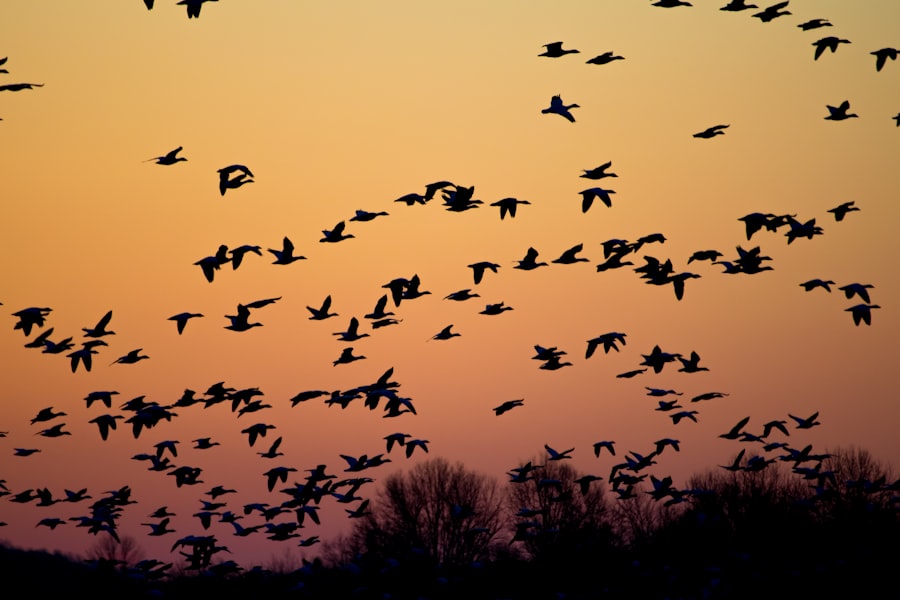
Creating a suitable habitat and environment for geese is crucial for their health and well-being. Geese require access to water for drinking, bathing, and cooling down. They also need ample space to graze and roam around. Ideally, geese should have access to a large pasture or paddock with plenty of grass and vegetation.
Water sources should be clean and easily accessible. Geese prefer shallow water where they can dip their heads and bodies. A small pond or a shallow trough filled with water can provide suitable drinking and bathing areas for geese.
Shelter is also important for geese, especially during extreme weather conditions. A simple shelter or shed can provide protection from rain, wind, and excessive heat. The shelter should be well-ventilated and spacious enough to accommodate the entire flock.
It is important to note that geese are social animals and thrive in the company of other geese. They should be kept in flocks rather than as solitary individuals. A flock of geese will establish a hierarchy and social structure, which helps maintain order within the group.
Overall, creating a suitable habitat and environment for geese involves providing access to water, ample grazing space, and appropriate shelter. By meeting these basic needs, geese can thrive and contribute to the agricultural practices on the farm.
The Nutritional Requirements and Feeding Habits of Geese in Australia
Geese have specific nutritional requirements that need to be met for optimal health and productivity. Their diet should consist of a balanced mix of grains, greens, and protein sources. Providing a varied diet ensures that geese receive all the necessary nutrients for growth, egg production, and overall well-being.
Grains such as corn, wheat, and barley are staple foods for geese. These grains provide energy and carbohydrates, which are essential for growth and maintenance. Grains can be fed whole or ground, depending on the age and size of the geese.
Greens are an important part of a goose’s diet, as they provide essential vitamins and minerals. Fresh grass, weeds, and leafy vegetables can be offered to geese on a daily basis. It is important to ensure that the greens are free from pesticides or other harmful chemicals.
Protein sources are crucial for muscle development and egg production in geese. Good sources of protein include soybean meal, fish meal, and poultry by-products. Protein can be provided in the form of pellets or mixed with grains to create a balanced feed ration.
In addition to their main diet, geese also require access to clean water at all times. Water is essential for digestion, hydration, and maintaining body temperature. Geese should have access to fresh drinking water as well as a shallow water source for bathing.
Feeding habits may vary depending on the age and purpose of the geese. Growing goslings require a higher protein content in their diet compared to adult geese. Laying geese may benefit from additional calcium supplementation to support eggshell formation.
It is important to monitor the body condition of geese and adjust their diet accordingly. Overfeeding can lead to obesity and health issues, while underfeeding can result in poor growth or egg production. Regularly assessing the body condition and adjusting the feed ration can help ensure that geese receive the appropriate amount of nutrients.
The Health and Disease Management of Geese in Australia
Like any livestock, geese are susceptible to various health issues and diseases. It is important for farmers to be aware of common health problems in geese and take preventive measures to ensure their well-being.
One common health issue in geese is respiratory infections. Geese can develop respiratory infections due to poor ventilation, overcrowding, or exposure to cold and damp conditions. Symptoms of respiratory infections include coughing, sneezing, nasal discharge, and difficulty breathing. Providing a well-ventilated shelter and avoiding overcrowding can help prevent respiratory infections.
Another common health issue in geese is foot problems. Geese that are kept on hard or uneven surfaces may develop foot injuries or infections. Providing a soft bedding material or access to grassy areas can help prevent foot problems in geese.
Parasites such as lice and mites can also affect the health of geese. Regularly inspecting geese for signs of parasites and treating them with appropriate medications can help prevent infestations.
Vaccinations are an important part of disease management in geese. Vaccines are available for diseases such as avian influenza and Newcastle disease, which can be highly contagious and devastating to a flock. Consultation with a veterinarian is recommended to determine the appropriate vaccination schedule for geese.
Regular check-ups by a veterinarian are also important for maintaining the health of geese. A veterinarian can perform routine health checks, administer vaccinations, and provide guidance on disease prevention and management.
By implementing good management practices, providing a clean and healthy environment, and seeking veterinary care when needed, farmers can ensure the health and well-being of their geese.
The Breeding and Reproduction of Geese in Australia
Breeding and reproduction are important aspects of goose farming in Australia. Understanding the breeding cycle of geese and implementing proper breeding practices can help ensure successful reproduction and the growth of the flock.
Geese are seasonal breeders, with the breeding season typically occurring in the spring. During this time, geese will engage in courtship behaviors, such as honking, head bobbing, and wing flapping. Males will often display aggressive behavior towards other males to establish dominance and attract a mate.
Selecting breeding pairs is an important consideration in goose farming. It is recommended to choose healthy, mature geese that exhibit desirable traits such as good body conformation, strong fertility, and good egg-laying capabilities. It is also important to avoid breeding closely related individuals to prevent genetic issues.
Once a breeding pair has been selected, they should be provided with a suitable nesting area. Geese prefer to nest on the ground, so providing a secluded area with soft bedding material can encourage nesting behavior. Females will lay a clutch of eggs over several days, typically ranging from 5 to 12 eggs.
Incubation of the eggs can be done naturally by the female goose or artificially using an incubator. Natural incubation takes approximately 28 to 35 days, during which the female will diligently sit on the eggs to keep them warm and provide moisture. Artificial incubation requires careful temperature and humidity control to ensure successful hatching.
After hatching, goslings should be provided with a warm and safe environment. They require access to clean water for drinking and bathing, as well as a balanced diet for growth and development. Goslings should be kept separate from adult geese until they are old enough to integrate into the flock.
Successful breeding and hatching can contribute to the growth and sustainability of a goose flock. By implementing proper breeding practices and providing appropriate care for goslings, farmers can ensure the continued success of their goose farming operation.
The Economic and Cultural Significance of Geese in Australia
Geese have both economic and cultural significance in Australia. From an economic perspective, goose farming can be a profitable venture. Geese are efficient converters of feed into meat and eggs, making them a cost-effective option for farmers. The demand for organic and free-range products has also contributed to the economic viability of goose farming.
In terms of cultural significance, geese have been a part of Australian cuisine and culture for many years. Goose meat is highly valued for its rich flavor and tenderness. It is often used in traditional dishes such as roast goose or goose confit. Goose eggs are also prized for their large size and rich yolk, making them a popular choice for baking and cooking.
Geese are also associated with various cultural traditions and festivals. In some regions, geese are used as part of parades or processions during holidays or special events. They are also featured in folklore and stories, symbolizing loyalty, protection, and fertility.
The future of geese in Australian agriculture and culture looks promising. With the increasing demand for sustainable farming practices and organic products, geese are likely to continue playing a significant role in Australian agriculture. Their unique characteristics, adaptability to the Australian climate, and their ability to contribute to weed management make them a valuable asset on farms and rural properties. Additionally, their cultural significance and contribution to Australian culinary traditions cannot be overlooked. Geese have long been a part of Australian culture, with their meat being a popular choice for special occasions and festive meals. Their rich flavor and versatility in cooking make them a sought-after ingredient in traditional dishes. As the demand for locally sourced and ethically raised food grows, geese are likely to become even more prominent in Australian cuisine. Furthermore, their presence in parks and public spaces adds to the cultural fabric of the country, as they are often enjoyed by locals and tourists alike. Overall, the future of geese in Australian agriculture and culture seems bright, with their unique qualities and contributions ensuring their continued relevance and importance.
If you’re interested in learning more about breeds of geese in Australia, you might also find this article on “When is Duck Mating Season?” helpful. Understanding the mating season for ducks can provide valuable insights into their breeding patterns and behaviors. To read more about this topic, click here.
FAQs
What are the different breeds of geese found in Australia?
There are several breeds of geese found in Australia, including the Chinese, Embden, Toulouse, and African geese.
What is the Chinese goose?
The Chinese goose is a breed of domesticated goose that originated in China. They are known for their distinctive knob on their beak and their loud honking.
What is the Embden goose?
The Embden goose is a breed of domesticated goose that originated in Germany. They are known for their white feathers and their large size.
What is the Toulouse goose?
The Toulouse goose is a breed of domesticated goose that originated in France. They are known for their large size and their grey feathers.
What is the African goose?
The African goose is a breed of domesticated goose that originated in Africa. They are known for their loud honking and their ability to lay a large number of eggs.
What are geese commonly used for in Australia?
Geese are commonly used for meat, eggs, and as pets in Australia. They are also used for weed control in some areas.
Meet Walter, the feathered-friend fanatic of Florida! Nestled in the sunshine state, Walter struts through life with his feathered companions, clucking his way to happiness. With a coop that’s fancier than a five-star hotel, he’s the Don Juan of the chicken world. When he’s not teaching his hens to do the cha-cha, you’ll find him in a heated debate with his prized rooster, Sir Clucks-a-Lot. Walter’s poultry passion is no yolk; he’s the sunny-side-up guy you never knew you needed in your flock of friends!

